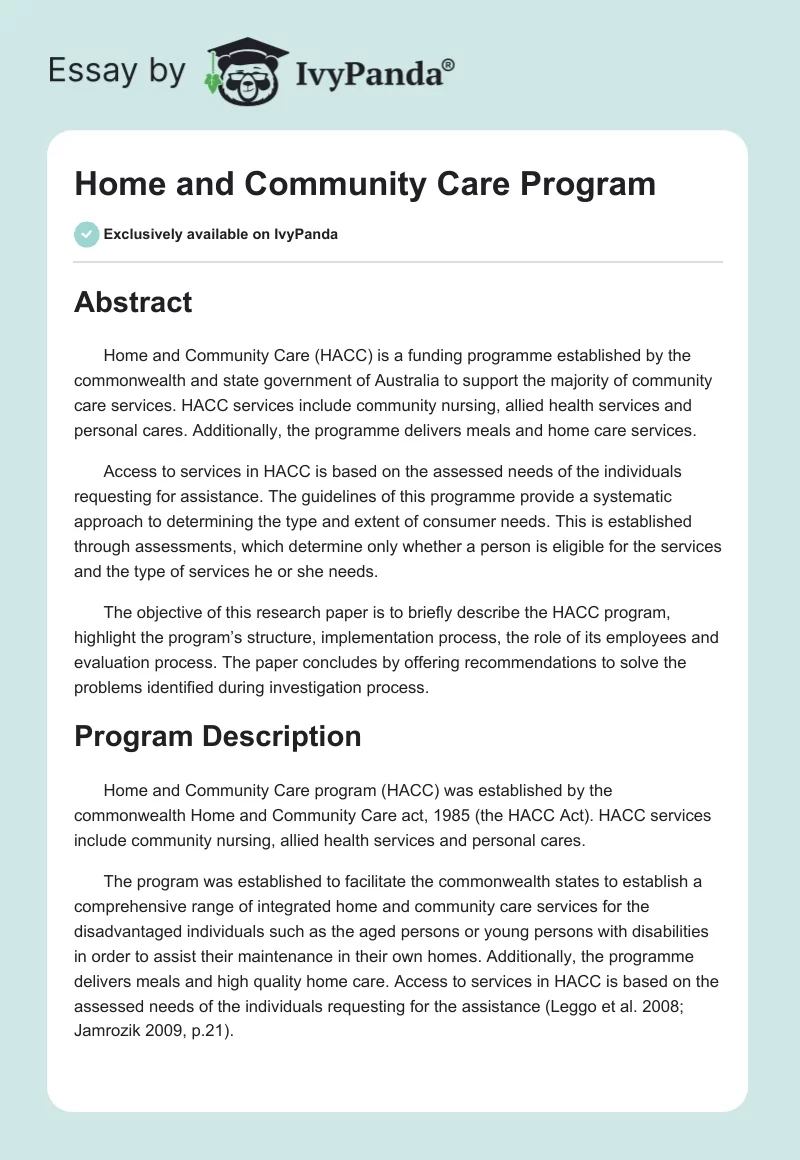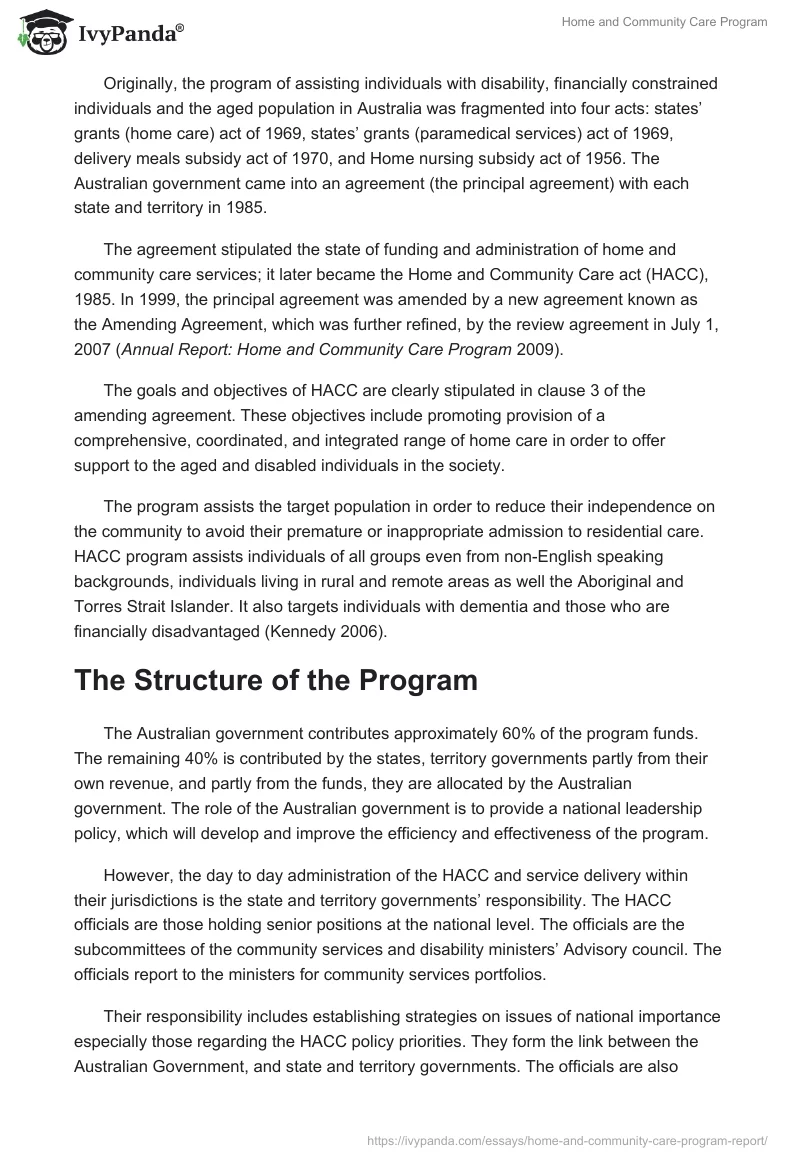Abstract
Home and Community Care (HACC) is a funding programme established by the commonwealth and state government of Australia to support the majority of community care services. HACC services include community nursing, allied health services and personal cares. Additionally, the programme delivers meals and home care services.
Access to services in HACC is based on the assessed needs of the individuals requesting for assistance. The guidelines of this programme provide a systematic approach to determining the type and extent of consumer needs. This is established through assessments, which determine only whether a person is eligible for the services and the type of services he or she needs.
The objective of this research paper is to briefly describe the HACC program, highlight the program’s structure, implementation process, the role of its employees and evaluation process. The paper concludes by offering recommendations to solve the problems identified during investigation process.
Program Description
Home and Community Care program (HACC) was established by the commonwealth Home and Community Care act, 1985 (the HACC Act). HACC services include community nursing, allied health services and personal cares.
The program was established to facilitate the commonwealth states to establish a comprehensive range of integrated home and community care services for the disadvantaged individuals such as the aged persons or young persons with disabilities in order to assist their maintenance in their own homes. Additionally, the programme delivers meals and high quality home care. Access to services in HACC is based on the assessed needs of the individuals requesting for the assistance (Leggo et al. 2008; Jamrozik 2009, p.21).
Originally, the program of assisting individuals with disability, financially constrained individuals and the aged population in Australia was fragmented into four acts: states’ grants (home care) act of 1969, states’ grants (paramedical services) act of 1969, delivery meals subsidy act of 1970, and Home nursing subsidy act of 1956. The Australian government came into an agreement (the principal agreement) with each state and territory in 1985.
The agreement stipulated the state of funding and administration of home and community care services; it later became the Home and Community Care act (HACC), 1985. In 1999, the principal agreement was amended by a new agreement known as the Amending Agreement, which was further refined, by the review agreement in July 1, 2007 (Annual Report: Home and Community Care Program 2009).
The goals and objectives of HACC are clearly stipulated in clause 3 of the amending agreement. These objectives include promoting provision of a comprehensive, coordinated, and integrated range of home care in order to offer support to the aged and disabled individuals in the society.
The program assists the target population in order to reduce their independence on the community to avoid their premature or inappropriate admission to residential care. HACC program assists individuals of all groups even from non-English speaking backgrounds, individuals living in rural and remote areas as well the Aboriginal and Torres Strait Islander. It also targets individuals with dementia and those who are financially disadvantaged (Kennedy 2006).
The Structure of the Program
The Australian government contributes approximately 60% of the program funds. The remaining 40% is contributed by the states, territory governments partly from their own revenue, and partly from the funds, they are allocated by the Australian government. The role of the Australian government is to provide a national leadership policy, which will develop and improve the efficiency and effectiveness of the program.
However, the day to day administration of the HACC and service delivery within their jurisdictions is the state and territory governments’ responsibility. The HACC officials are those holding senior positions at the national level. The officials are the subcommittees of the community services and disability ministers’ Advisory council. The officials report to the ministers for community services portfolios.
Their responsibility includes establishing strategies on issues of national importance especially those regarding the HACC policy priorities. They form the link between the Australian Government, and state and territory governments. The officials are also responsible in monitoring the HACC program is meeting its objectives efficiently and effectively, and developing of the mechanisms to achieve a better and consistent HACC program service delivery (Annual Report: Home and Community Care Program 2009).
The National Aboriginal and Torres Strait Islander HACC reference group are also part of the HACC organizational structure. The group was established to provide leadership in the national HACC program, offer advice on policy planning, and promote debate and discussions on matters regarding the Aboriginal and Torres Strait Islander people. This reference groups reports to the HACC officials (Annual Report: Home and Community Care Program 2009).
Implementation of the Program
The program is implemented through three broad stages (The HACC Manual: Home and Community Care Program 2010; Kennedy 2006):
- Planning: This stage involves setting the state wide requirements priorities, and identifying regional needs through quantitative assessment to facilitate service planning
- Development and assessment of proposals: This stage scrutinizes state and regional service delivery proposals highlighted by various HACC agencies. Selection by regional assessment panels takes place. Selection is determined by the need of the service in the region.
- Approval and funds allocation: The regional panel approval of the proposals permits the officials to allocate funds to the agencies.
Staff Role in the Program
The organization personnel are involved in the assessment of the client’s needs. Therefore, HACC ensures that their personnel have a diverse professional background. The staff members are required to possess skills and knowledge appropriate for their role. There undergo pre-service and in-service training to suit their diversified assessment tasks assigned.
The staff is required to have a strong base values and interpersonal attributes such as advocacy, listening, empathy, and caring. However, the HACC program facilitators are establishing firmer qualification requirements in order to strengthen the workplace as a site for professional advancement and association (Lindeman & Pedler 2008).
Evaluation Process
The HACC program guidelines articulately describe the assessment procedures. It lays a systematic pathway of determining the extent of support a consumer needs. This facilitates the identification range of appropriate home and community care services. The role of evaluation is to determine the eligibility of the consumer and the identification of the type of services required. In this process, HACC are the first client’s point of contact.
This is a very critical stage in the entire client’s involvement with HACC. Assessment process in the HACC program has been identified as the area that needs improvement especially with the recognition that conceptual, ideological and ideological practices have resulted to inequity in service delivery, generating tensions in some local service networks and consumer interested groups.
This trend has generated a cornerstone phenomenon in the assessment process, which states that HACC service delivery should be dictated by consumer needs and not HACC services needs. The national HACC program guidelines describe the assessment mechanisms, which are independent of service provision for consumers (Lindeman 2009).
Eligibility for agencies under the HACC program is established by individual state and territory governments. They assess the needed services in the regions and select the appropriate organization/agencies to provide those services. The agencies are required to deliver services in accordance to the National Service Standards and the National HACC program guidelines 2007. The outcome of the evaluation process depends entirely on the quality of the assessment.
There are various standards of practice set out for the assessors. These standards of practice covers areas such as developing cooperative relationships, collection of clients data, assessing of certain domains pertaining to the clients’ careers and other development plans. The HACC is responsible in ensuring that the staff has the necessary skills, experience and training in order to deliver a high standard of assessment (Lindeman & Pedler 2008).
In 2007, the Australian government, and state and territory governments identified the need for mechanism to evaluate HACC performance in order to ensure that it delivers its services appropriately. It established a performance assessment framework, which comprised of seven indicators. The first three Key Performance Indicators (KPIs) are those regulating the equity, the fourth, fifth and sixth KPIs evaluate the program’s effectiveness and the seventh one measures the program’s efficiency.
KPI 1 evaluates the equity in HACC service delivery on the target population. The HACC target population is determined by estimating the age, sex and specific rates for persons living in the moderate, severe or profound core economic activity restrictions. KPI 2 focuses on the Aboriginal and Torres Strait Islander people to assess target population of this particular group accessing the HACC services in order to ensure equity.
The HACC is committed to deliver quality services to its clients as stipulated by KPI 4 framework, which lays those primary objectives of ensuring quality results for clients. The frameworks are the HACC National Service Standards. The standards were established to ensure that the clients receive assistance according to their constitutional rights and without biasness.
Following the standards, the National Service Standards Instruments (NSSI) was developed to offer a consistent method to evaluate and monitor the quality of service delivery as well as assist in the planning aspects of the service delivery system.
HACC uses the KPI 5 framework to evaluate the performance of the agency in order to determine whether its management complies with the established requirements. The agencies are required to provide data to the HACC MDS. Financial funds management in the HACC is monitored by KPI 6. All HACC funded agencies are required to provide their financial acquittals to their respective state and territory departments.
The financial acquittal is the annual financial reconciliation of the agency outlining how the allocated funds were spent. The acquittals facilitate the state and territories to compile average unit cost reports as stipulated by unit cost for key service types. KPI 7 guards against money laundering activities through dubious charitable agencies (Annual Report: Home and Community Care Program 2009).
Conclusion
HACC services include community nursing, allied health services and personal cares. Additionally, the programme delivers meals and quality home care services. Access to services in HACC is based on the consumer’s needs. This program is provided with a systematic guideline to determine the type and extent of the consumer needs. This is established through assessments, which determines only whether a person is eligible for the services and the type of services the customer needs.
Despite the usefulness of the HACC program, it suffers quite a number of challenges. Strategies to mitigate these challenges includes improving the cultural awareness and understanding of the communities, and further training enhancement for the assessors in order to improve assessment and care planning decisions in Australia. The training focuses on equipping the assessors with solid and conceptual frameworks highlighted by Australian government, and state and territory governments.
References
Annual Report: Home and Community Care Program 2009. Web.
Jamrozik, A 2009, Social policy in the post welfare state: Australian Society in changing world, Pearson education Australia, French Forest.
Kennedy, R 2006, Home and community care program: guidelines for HACC program capital projects. Web.
Leggo et al. 2008, ‘A quality improvement nutrition screening and intervention program available to home and community care eligible clients’, Nutrition and Dietetics, vol. 65, no. 1, pp. 162-167, EBSCOhost Database.
Lindeman, M & Pedler, R 2008, ‘Assessment of indigenous older people needs for home and community care in remote central Australia’, Journal of Cross Cult Gerontology, vol. 23, no. 1, pp. 85-95, EBSCOhost database.
Lindeman, M 2009, ‘Assessment staff in home and community care services: Issues of learning and professional identity in Australia’, Health and Social Care in the Community, vol. 17, no. 4, pp. 406-414, EBSCOhost database.


